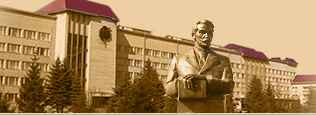GELIORESOURS AND RESOURCES OF SOLAR RADIATION OF THE KHMELNITSK REGION.
In the article demonstrates to the feature of distribution of Gelioresours and resources of solar radiation within the limits of the Khmelnytsk area. A publication contains data of all weather-stations of the Khmelnytsk area about the height of a sun, duration of day, duration of sunny refulgency, distribution of total solar radiation and radiation balance, reiterations of cloudy, clear and half clear weather after seasons and months. Duration of sunny refulgency for a year increases from a north south of 1800 to 1950 hours. In January duration of sunny refulgency changes from 49 to 52 hours, in July from 259 to 294 hours, and in December from 34 to 43 hours from a north southward. On the south of the Khmelnytsk area duration of sunny refulgency arrives at 1950 hours and more on terraces and slopes of valley of Dnister. Duration of sunny refulgency stipulates arrival of solar radiation and in turn they depend on a cloudiness. At the increase of cloudiness a direct and total solar radiation diminishes, and radiation balance increases. It contingently strong reduction of expense part of radiation balance is an effective radiation, at a large cloudiness. A cloudiness diminishes from 7 points in the north to 5 points on the south of area. The least cloudiness on the average is characteristic for August and September, and most for November, December, January and February (8-9 points). From data of reference books on a climate tables are made 9 and 10, the amount of clear and cloudy days is shown in that, and also clear and cloudy weather on months and seasons of year. Number of days with a cloudy weather (8-10 points) in winter in 2,5 times more than in summer, accordingly, 50-54 and 17-20 days. Large repetition of cloudy weather is conditioned by intensification of cyclone activity with passing of atmospheric fronts in a cold season, when the ways of atlantic cyclones are displaced southward to the subtropical belt. South part of the Khmelnytsk area is open for access of the air masses from the Black sea, where local cyclones are formed in winter, and in summer for continental and marine tropical air. Influence of analized parameters is represented also on development of energy, recreational sphere and agriculture of the Khmelnytsk area.
Keywords: Podolica, Khmelnytsk area, duration of day, height of a sun, sunny refulgency, total solar radiation, radiation balance.
References:
- Klimat Ukrainy. (Za red.. V.M.Lipinskoho, V.A.Diachuk, V.M.Babychenko). –Kyiv: vyd-vo Raievskoho, 2003.- 343 s.
- Cherniuk H.V. Klimatychni resursy Podillia / H.V. Cherniuk, P.L. Tsaryk // Naukovi zapysky Ternopilskoho natsionalnoho pedahohichnoho universytetu imeni Volodymyra Hnatiuka. Seriia: Heohrafiia. №1. – Ternopil: TNPU, 2008. – S.50-59.
- Tsaryk L.P. Pryrodni rekreatsiini resursy: metody otsinky ta analizu (na prykladi Ternopilskoi oblasti) / L.P.Tsaryk, H.V.Cherniuk. – Ternopil: Pidruchnyky i posibnyky, 2001. – S. 21-80.
- Spravochnyk poklymatu SSSR. Vy10. Chast 1. Solnechnaia radyatsyia, radyatsyonnyi balans y solnechnoe syianye. – Lenynhrad: Hydrometeoyzdat, 1966 – 124s. Chast 3. Temperatura vozdukha y pochvy. – L.:Hydrometeoyzdat, 1969. – 607 s. Chast 5. Oblachnost y atmosfernye javlenyia. – L.: Hydrometeoyzdat, 1969. – 161 s.
